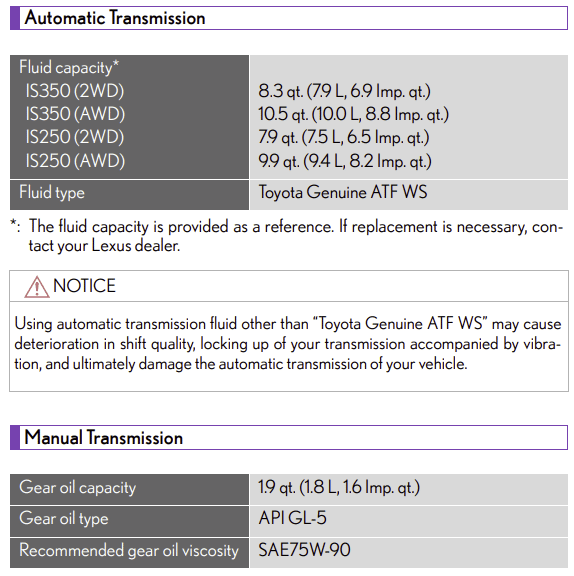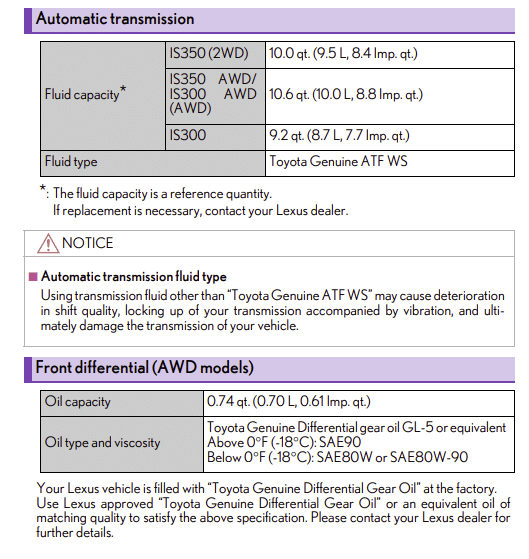In the realm of vehicle maintenance, few things are as paramount yet often overlooked as the selection and maintenance of transmission fluid. Just as the heart needs the right kind of blood to function at its peak, a car’s transmission requires the correct fluid to ensure smooth operation and a prolonged lifespan.
Utilizing the appropriate transmission fluid is not merely a matter of achieving optimal performance—it’s about preserving the intricate mechanics of your vehicle and preventing costly repairs down the line.
The transmission fluid type varies based on model year and specific transmission configuration. Typically, for many Lexus IS models, the recommended types are ATF WS or T-IV, but always check your owner’s manual.
A vehicle’s transmission acts as the bridge between the engine and the wheels, and the fluid acts as both a lubricant and coolant, facilitating gear shifts, reducing friction, and preventing overheating.
The Lexus IS series, since its inception, has epitomized the blend of luxury and performance that the Lexus brand is renowned for. Launched in 1998 as part of Toyota’s luxury division, the IS was envisioned to compete with European compact luxury cars, targeting younger customers with a penchant for performance.

The first generation, the XE10 (2001-2005), signaled Lexus’s ambition to tap into the sport sedan segment, offering a perfect blend of refined luxury with athletic prowess. As the series evolved, the second generation, the XE20 (2006-2013), continued this legacy, further refining its aesthetic appeal and driving mechanics. Notably, the XE20 introduced various facelifts, continually updating its design and technology to cater to contemporary tastes.
With the arrival of the third generation, the XE30 (2014-present), the Lexus IS underwent significant overhauls, featuring aggressive design cues and technological advancements that strengthened its position in the luxury sports sedan market. The subsequent facelifts within the XE30 generation are a testament to Lexus’s commitment to innovation, consistently updating the model to meet and exceed the ever-evolving standards of the segment.
This rich history underscores the importance of understanding and maintaining the unique requirements of each Lexus IS generation, including the vital component of transmission fluid.
Lexus IS Transmission Fluid Capacity And Transmission Fluid Type
1st Gen (XE10) 2001-2005 Lexus IS

The 1st generation Lexus IS, known as XE10, primarily consisted of the IS 300 model in various global markets. Equipped with an inline-6 engine, it was available in both automatic and manual transmissions. Here’s a breakdown of the transmission fluid capacity and type for this generation:
- Lexus IS 300 Automatic (5-speed A650E Transmission)
- Fluid Capacity:
- Drain and Refill: Approx. 2.5 qt. (2.4 L)
- Total Fill: Approx. 8.5 qt. (8 L)
- Fluid Type: Toyota Type T-IV
- Fluid Capacity:
- Lexus IS 300 Manual (W55 Transmission)
- Fluid Capacity:
- Drain and Refill: Approx. 1.3 qt. (1.2 L)
- Total Fill: Not typically done for manual transmissions as a drain and refill is usually sufficient.
- Fluid Type: GL-4 or GL-5, 75W-90
- Fluid Capacity:
Periodically checking the fluid level and ensuring it’s of the correct type is crucial for maintaining the car’s performance and longevity.
2006-2013 Lexus IS

The second generation Lexus IS, the XE20 series, showcased a broader range of engine options, including V6 variants, and expanded its lineup. This generation marked a significant evolution in design, technology, and powertrains for the Lexus IS. Here’s the breakdown of the transmission fluid capacity and type for this generation:

- Lexus IS 250 Automatic (6-speed A960E Transmission)
- Fluid Capacity:
- Drain and Refill: Approx. 2 qt. (1.9 L)
- Total Fill: Approx. 7.9 qt. (7.5 L)
- Fluid Type: Toyota WS (World Standard)
- Fluid Capacity:
- Lexus IS 250 Automatic (6-speed A760H Transmission)
- Fluid Capacity:
- Drain and Refill: Approx. 1.6 qt. (1.5 L)
- Total Fill: Approx. 9.9 qt. (9.4 L)
- Fluid Type: Toyota WS (World Standard)
- Fluid Capacity:
- Lexus IS 250 Manual (6-speed RA62 Transmission)
- Fluid Capacity:
- Drain and Refill: Approx. 1.9 qt. (1.8 L)
- Total Fill: Not typically done for manual transmissions as a drain and refill is often adequate.
- Fluid Type: GL-5, 75W-90
- Fluid Capacity:
- Lexus IS 350 Automatic (6-speed A760E Transmission)
- Fluid Capacity:
- Drain and Refill: Approx. 1.9 qt. (1.8 L)
- Total Fill: Approx. 8.3 qt. (7.9 L)
- Fluid Type: Toyota WS (World Standard)
- Fluid Capacity:
Proper maintenance, including periodic checks and the use of the correct transmission fluid, is pivotal in preserving the car’s smooth operation and overall lifespan.
2014-Present Lexus IS

The XE30 series marked the third generation of the Lexus IS, showcasing a more aggressive design, enhanced technology, and new powertrain options. Here’s the transmission fluid specification for the initial release:

- Lexus IS 250 RWD Automatic (6-speed A960E Transmission)
- Fluid Capacity:
- Drain and Refill: Approx. 1.5 qt. (1.4 L)
- Total Fill: Approx. 7.9 qt. (7.5 L)
- Fluid Type: Toyota WS (World Standard)
- Fluid Capacity:
- Lexus IS 250 AWD Automatic (6-speed A760H Transmission)
- Fluid Capacity:
- Drain and Refill: Approx. 1.7 qt. (1.6 L)
- Total Fill: Approx. 9.9 qt. (9.4 L)
- Fluid Type: Toyota WS (World Standard)
- Fluid Capacity:
- Lexus IS 300 RWD Automatic (8-speed AA81E Transmission)
- Fluid Capacity:
- Drain and Refill: Approx. 3.4 qt. (3.2 L)
- Total Fill: Approx. 9.2 qt. (8.7 L)
- Fluid Type: Toyota WS (World Standard)
- Fluid Capacity:
- Lexus IS 300 AWD & IS 350 AWD Automatic (6-speed A760E/A760H Transmission)
- Fluid Capacity:
- Drain and Refill: Approx. 1.7 qt. (1.6 L)
- Total Fill: Approx. 10.6 qt. (10 L)
- Fluid Type: Toyota WS (World Standard)
- Fluid Capacity:
Facelift 2021-Presents Lexus IS

The second facelift saw subtle design tweaks, with a focus on luxury enhancements and updated technology:
- Lexus IS 300 RWD & IS 350 RWD Automatic (8-speed Automatic Transmission)
- Fluid Capacity:
- Drain and Refill: Approx. 3.4 qt. (3.2 L)
- Total Fill: 10 qt. (9.5 L)
- Fluid Type: Toyota WS (World Standard)
- Fluid Capacity:
- Lexus IS 500 Automatic (8-speed Direct-Shift Transmission)
- Fluid Capacity:
- Drain and Refill: Approx. 3.9 qt. (3.7 L)
- Total Fill: 11.4 qt. (10.8 L)
- Fluid Type: Toyota WS (World Standard)
- Fluid Capacity:
- Lexus IS 300 AWD & IS 350 AWD Automatic (6-speed Transmission)
- Fluid Capacity:
- Drain and Refill: Approx. 3 qt. (2.8 L)
- Total Fill: Approx. 10.6 qt. (10 L)
- Fluid Type: Toyota WS (World Standard)
- Fluid Capacity:
Always consult the vehicle’s owner manual, or an authorized Lexus dealer, for the most accurate and up-to-date information specific to your model.
The Role of Transmission Fluid in Lexus IS
Automobile enthusiasts and engineers alike will affirm the profound significance of transmission fluid in the mechanics of a vehicle. Often likened to the lifeblood of the transmission system, this fluid fulfills multiple roles that are essential for the vehicle’s overall health and performance.
Function in Ensuring Smooth Operation
- Lubrication: At its core, transmission fluid acts as a lubricant for the myriad of moving parts inside a transmission. Whether you’re dealing with an automatic or manual system, the gears, bearings, and other components require this lubrication to function without grinding against each other. Without the fluid, these parts would wear down rapidly, leading to eventual system failure.
- Coolant: Transmissions generate heat, especially under intense driving conditions. The fluid circulates through the system, absorbing this heat and transferring it to a cooler, thereby regulating the transmission’s temperature. By doing so, it prevents the transmission from overheating, ensuring it operates efficiently even during prolonged drives or under heavy loads.
- Transmission of Power: In automatic transmissions, the fluid plays a role in the torque converter, transmitting power from the engine to the transmission. It facilitates the necessary hydraulic pressure for gear shifts, allowing for seamless transitions between speeds.
- Protection and Cleaning: Modern transmission fluids often come with additives that prevent rust and corrosion, as well as detergents that keep the internals of the transmission clean. These additives help prolong the transmission’s life and keep it functioning optimally.
Detrimental Effects of Incorrect Fluid Type or Depleted Levels
- Performance Issues: Using the wrong type of fluid can hinder the transmission’s performance. For instance, it can lead to erratic shifting, loss of acceleration, or even prevent the vehicle from moving. The viscosity and additives in the fluid are designed specifically for certain transmissions, and deviating from this can cause malfunctions.
- Increased Wear: Incorrect fluid lacks the necessary properties to adequately lubricate and protect the transmission’s internals. This can lead to increased wear and tear, significantly reducing the transmission’s lifespan.
- Overheating: Depleted fluid levels or the wrong type can result in inadequate cooling of the transmission. Overheating can cause parts to warp, seals to break, and in extreme cases, complete transmission failure.
- Costly Repairs: Ultimately, the repercussions of neglecting the transmission fluid—be it through using the incorrect type or letting it run low—can lead to extensive and expensive repairs or replacements. Regularly checking and maintaining the right transmission fluid is an investment in the vehicle’s longevity and can save substantial costs in the long run.
Checking and Replacing Transmission Fluid for Lexus IS
Maintaining your vehicle’s transmission fluid is essential for the longevity and performance of the transmission. Here’s a basic guideline for checking and replacing the transmission fluid in a Lexus IS:
Checking the Fluid’s Level and Quality
- Vehicle Preparation:
- Park the vehicle on a level surface.
- Start the engine and let it idle until it reaches normal operating temperature.
- Shift the transmission through all gears and then back to ‘Park’ or ‘Neutral’. This ensures the fluid circulates through all parts.
- Checking the Level:
- Many modern Lexus vehicles do not come with a traditional dipstick for checking transmission fluid. Instead, there’s a service port on the transmission.
- If your Lexus has a dipstick:
- Pull it out, wipe it clean, and reinsert it fully.
- Pull it out again and note the fluid level. It should be between the ‘Hot’ and ‘Cold’ marks.
- If your Lexus does not have a dipstick:
- It’s best to consult a Lexus technician or follow the specific service manual for your vehicle model.
- Checking the Quality:
- The fluid should be a transparent red color. If it’s dark or has a burnt smell, it might need replacement.
- If you see metal particles in the fluid, it’s a sign of internal wear, and you should consult a mechanic immediately.
Draining and Refilling Transmission Fluid
Remember: Safety first. Always wear protective gloves and safety goggles.
- Preparation:
- Ensure the car is on a level surface.
- Use jack stands to securely elevate the car if necessary. Never rely solely on a jack.
- Draining the Fluid:
- Place a drain pan under the transmission’s drain plug.
- Open the plug using the correct size socket or wrench. Allow the fluid to drain completely.
- Replacing the Filter (recommended, especially for older models):
- Locate the transmission fluid pan and remove it by undoing the bolts.
- Carefully remove the old filter. It might still have some fluid.
- Replace it with a new filter and ensure it fits snugly.
- Refilling the Fluid:
- Once the fluid is drained and the filter replaced (if you’re doing that step), reinstall the drain plug.
- Through the transmission fill port or dipstick tube (depending on the model), use a funnel to add the fresh transmission fluid. Do not overfill; always refer to the specified capacity in the owner’s manual.
- Final Checks:
- Start the engine and shift through all gears a few times, then back to ‘Park’ or ‘Neutral’.
- Check the fluid level again as described above. Top off if necessary.
- Check for any leaks around the drain plug and pan.
- Dispose of Old Fluid:
- Old transmission fluid should be disposed of at a proper recycling center or facility. Never pour it down drains or onto the ground.
Regularly checking and maintaining the transmission fluid will ensure your vehicle runs smoothly and prolong the life of your transmission. If you’re uncertain or uncomfortable with any part of the process, always consult or hire a professional mechanic or technician.
Frequently Asked Questions: Lexus IS Transmission Fluid
- How often should I change my Lexus IS transmission fluid?
- Typically, for many vehicles, transmission fluid should be changed every 30,000 to 60,000 miles. However, always refer to your Lexus IS owner’s manual for the manufacturer’s specific recommendations.
- Is it necessary to change the transmission filter?
- Yes, especially for older models. Changing the filter ensures that contaminants captured by the filter don’t circulate back into the transmission. It’s a good practice to change the filter when you change the fluid.
- Can I use any brand of transmission fluid for my Lexus IS?
- While there are many brands offering high-quality transmission fluids, it’s crucial to use the type specified for your Lexus IS model. Always refer to your owner’s manual or consult a Lexus technician.
- What happens if I use the wrong type of transmission fluid?
- Using the wrong type can lead to shifting issues, reduced fuel efficiency, or even severe transmission damage. It’s essential to ensure you use the correct fluid type.
- I’ve noticed a leak under my car. Could it be the transmission fluid?
- Possibly. Transmission fluid is typically red (though it can darken over time). If you spot a red or dark brown fluid leak, it might be transmission fluid. It’s essential to address any leaks promptly to prevent transmission damage.
- Why does my transmission fluid look dark or smell burnt?
- Dark or burnt-smelling transmission fluid can be a sign of overheating, aging, or internal wear and tear. If you notice these symptoms, it might be time for a fluid change, and you should consult a mechanic.
- Is changing transmission fluid a task I can handle at home?
- With the right tools and knowledge, yes. However, if you’re unfamiliar with the process, it might be best to hire a professional. Modern vehicles, like the Lexus IS, can have intricate systems, and it’s essential to follow the procedure correctly.
- Can I mix old and new transmission fluid?
- While it’s technically possible, it’s not recommended. Mixing old and new fluid can dilute the effectiveness and quality of the new fluid. It’s always best to fully drain and replace with fresh fluid.
- What if I overfill my transmission fluid?
- Overfilling can lead to foaming, erratic shifting, and potential transmission damage. If you suspect you’ve overfilled, it’s essential to drain the excess fluid to the appropriate level.
- How important is it to maintain my transmission fluid?
- Very important! Properly maintained transmission fluid ensures smooth shifting, efficient operation, and prolonged transmission life.
Remember, the above answers provide general guidance, and specifics might vary based on your Lexus IS model, year, and condition. Always refer to the vehicle’s owner’s manual or consult a Lexus technician for model-specific advice.
References and Resources
- Lexus Official Service Manuals
- Club Lexus Forums – IS Series
- Lexus IS Owner’s Manual (select the year and model)
- Lexus Enthusiast Community
- YouTube: Lexus IS Transmission Fluid Change Tutorials
Remember, the digital world is ever-evolving, and while these resources are beneficial now, always keep an eye out for updated information, especially from the official Lexus sources. Regularly consulting your vehicle’s manual and trusted mechanics will keep you in the know and your car in peak condition.
















